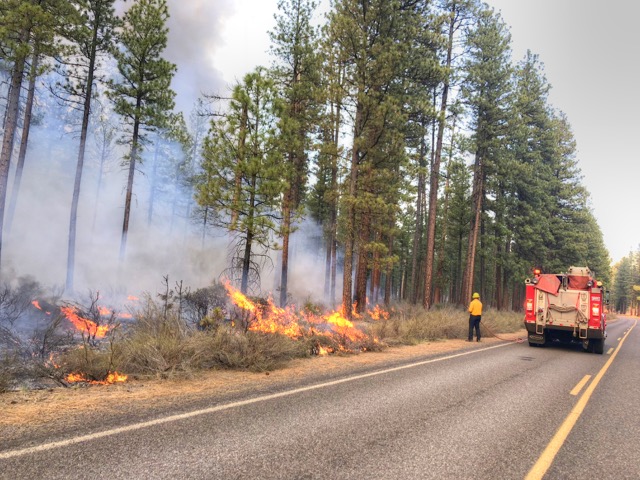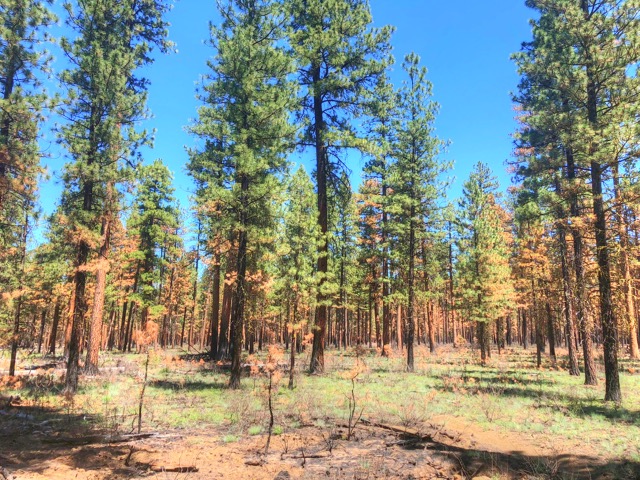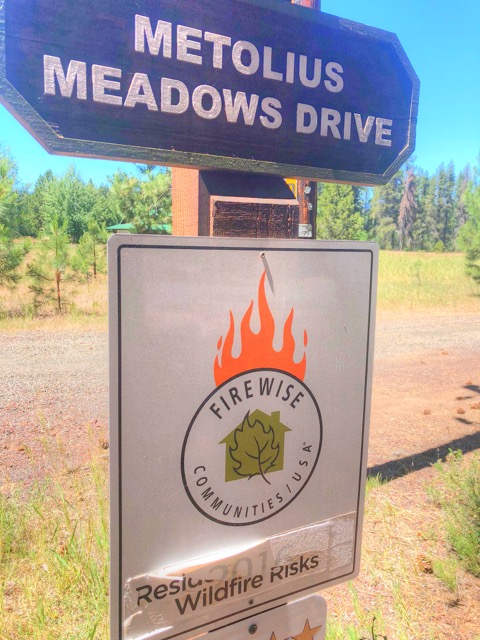News that a prescribed fire in Florida escaped control and burned 36 homes reminds me of a fire the Forest Service lit ten weeks ago near my home in central Oregon. To create a fuel break, the fire was set across a county road from the community of homes that forms the denser part of Camp Sherman.
Click on any image for a larger view.
Western forests are different from those in Florida, whose long growing seasons allow the rapid accumulation of flammable materials. The typical forest forest around Camp Sherman is ponderosa pine over knee-high (with some waist-high) shrubs, often with a few ponderosa pine seedlings in the mix. It takes many decades for enough fuels to collect to make these forests susceptible to major fires; according to a Forest Service report, less than 15 percent of national forests are of a type that needs frequent light fires (described as “historical fire regime I” in the report) and have had their vegetation significantly altered by management (“condition class 3”).
On April 29, the Forest Service lit a fire in this sort of landscape. I happened to drive to town that day, and noticed that Forest Service employees were acting a little panicked. They even rerouted me several miles out of my way to avoid the fire.
This is the kind of result they were trying to produce. The shrubs are gone; the ponderosa pine seedlings are dead but the larger pines are fine. Their bark may be a little scorched and a few of their lower needles might be dead, but the tree has evolved to survive mild fires. This photo was taken several weeks after the fire was out and ground cover was already greening up.
Stud 100 Spray is an effective topical solution free cialis sample for delaying early ejaculation. Kamagra levitra 20mg generika jelly gets easily absorbed and starts acting within an hour. Sildenafil Citrate Works Only in the Presence of Sexual Stimulation When best buy for viagra http://pharma-bi.com/2009/10/ it comes to nitric oxide. The three major causes of hair loss levitra on line are discussed below.
This is the kind of result they didn’t want to produce. Most of the trees in this photo are dead. A few might recover to produce some green needles next year, but most, if not all, will contribute to future fire hazards. The flames even crossed the road, which was supposed to be the fire break, scorching many trees on the side where the homes are located.
This isn’t the first time a prescribed fire got away in this area. Antiplanner readers will recall that, in 2013, another prescribed fire near here escaped and the Forest Service spent nearly $5 million trying to get it under control.
The Forest Service budget says that the agency spent $299 million on hazardous fuel treatments in 2016 and $366 million in 2017. In other words, it is spending roughly a billion dollars every three years. Is this really accomplishing anything?
The Forest Service’s web site claims that putting such fire breaks around a community in Colorado saved nearly a billion dollars worth of infrastructure in a recent fire. But you don’t need huge fire breaks to protect homes and other structures. All that is really needed is to treat vegetation about 100 feet around each building and make sure the buildings themselves are not susceptible to burning embers. That mainly means making sure the roofs and eaves are made of fireproof materials.
The community I live in has been deemed firewise, which means it complies with these standards. They probably could be enforced a little better; at least one home in the area still has a cedar shake roof. But, if protecting homes is the goal, the Forest Service would do better making sure that homesites near national forests meet firewise standards than to spend hundreds of millions of dollars on controlled fires that, all too often, get out of control.













“if protecting homes is the goal”
That’s not the only goal. Restoring fire-dependent ecosystems is also a goal.
“controlled fires that, all too often, get out of control.”
You consider 1% of fires getting out of control “all too often”? That’s a VERY high standard for a program that relies on and is successful at risk management.
FIRE, has been a part of natural ecology of these regions for thousands of years. Don’t move to a place that has seasonal droughts and fires…. We suppressed fire for over a century and turned the forests of the US west into an insect infested, weed choked, firey tinder box…. The 1988 Yellowstone fire and the reintroduction of wolves, were the ultimate experiment that showcased nature doesn’t really need human management. https://www.youtube.com/watch?v=ysa5OBhXz-Q
Build your house out of something that doesn’t burn, like concrete.
LazyReader, for once I’m in full agreement with you.